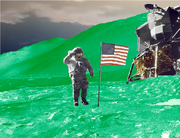The Apollo 11 Moon Landing was the spaceflight that landed the first humans on Luna on July 20, 1969. The mission, carried out by the United States, is considered a major accomplishment in the history of the Space Race and of exploration. Launched from Florida on July 16, it was the third manned mission, and the third lunar mission of NASA's Apollo program, was crewed by Commander Neil Armstrong, Command Module Pilot Michael Collins, and Lunar Module Pilot Edwin "Buzz" Aldrin, Jr. The crew finally landed on Luna on July 20. They had landed several miles beside the Sea of Tranquility and on July 21 became the first humans to walk on the Moon. It was there that the crew had found an established city near the Sea of Tranquility. This was the key event that led to the Colonization Movement.
Events of the mission[]

Apollo 11 landing site.
On July 20, 1969, the Apollo 11 was approaching the Moon. As the crew got closer and closer, they noticed more of the oceans and the land, and they and the 600 million people watching from home realized the Moon and Earth looked almost identical. The spacecraft safely landed on Luna at 20:17:40 UTC. Instead of landing in the Sea of Tranquility, they landed near the coast of the continent, not wanting to risk something going wrong and the crew drowning in the water.

Buzz Aldrin staring at the New World.
Once they got closer and closer to the landing site they noticed the various species thriving on the Lunar surface. They narrowly avoided landing on a family of wild "Kertunis," a species similar to panda bears. They walked out of the module and it was Neil Armstrong that was the first human to ever step on the Lunar surface. He knelt down to get a better look at the surface, covered with grass and moss, and uttered the famous line, "That's one small step for man, one giant leap for mankind" six hours after landing. The astronauts had walked around the surface, discovering how its low gravity made it easier to get around. They had taken dozens of samples and rocks covered with algae and moss with possible traces of life and even taking insects that were never seen before on Earth, too.
They had walked towards the edge of the surface and planted the U.S. flag on the Lunar surface, this time having the flag waving in the breeze. Neil Armstrong had continued to walk with the camera until they found themselves at a cliff. "The view was breathtaking," Buzz Aldrin said later in an interview. "We were staring down the cliff thinking we would see a large forest, plant and animal life, and all we see are buildings! Actual buildings obviously made by actual people." Armstrong was skeptical at first, then he wondered if the atmosphere was breathable.

Aldrin saluting the U.S. flag.
It was then that Richard Nixon called them on a telephone-radio transmission, congratulating them on their discovery, hoping they would come back safely.
The crew continued to map the city. Aldrin had smiled at the camera and said, "We found it, everyone, we found Earth's sequel; Earth II," a line that has been mentioned in various news reports, novels and magazines, and what some magazines state is "possibly more famous than Armstrong's line."
Aldrin suggested that the crew should check out the various buildings in the distance, but Armstrong didn't want to interfere with the possibility of intelligent life. They continued taking samples of plants, minerals, and even vegetation found, suggested by NASA, just in case the crew ever stays for a long-term period of time, they could use a food supply on the Moon. The crew continued to do this for a few hours until it was time to leave Luna for Earth, but not before Aldrin saluted the flag.
Their landing craft, Eagle, spent 21 hours and 31 minutes on the lunar surface while Collins orbited above in the command ship, Columbia. The three astronauts later returned to Earth with 47.5 pounds (21.5 kg) of lunar rocks and several species of insects along with various food supplies not seen on Earth. The crew landed in the Pacific Ocean on July 24.
| |||||||||||||||||||

